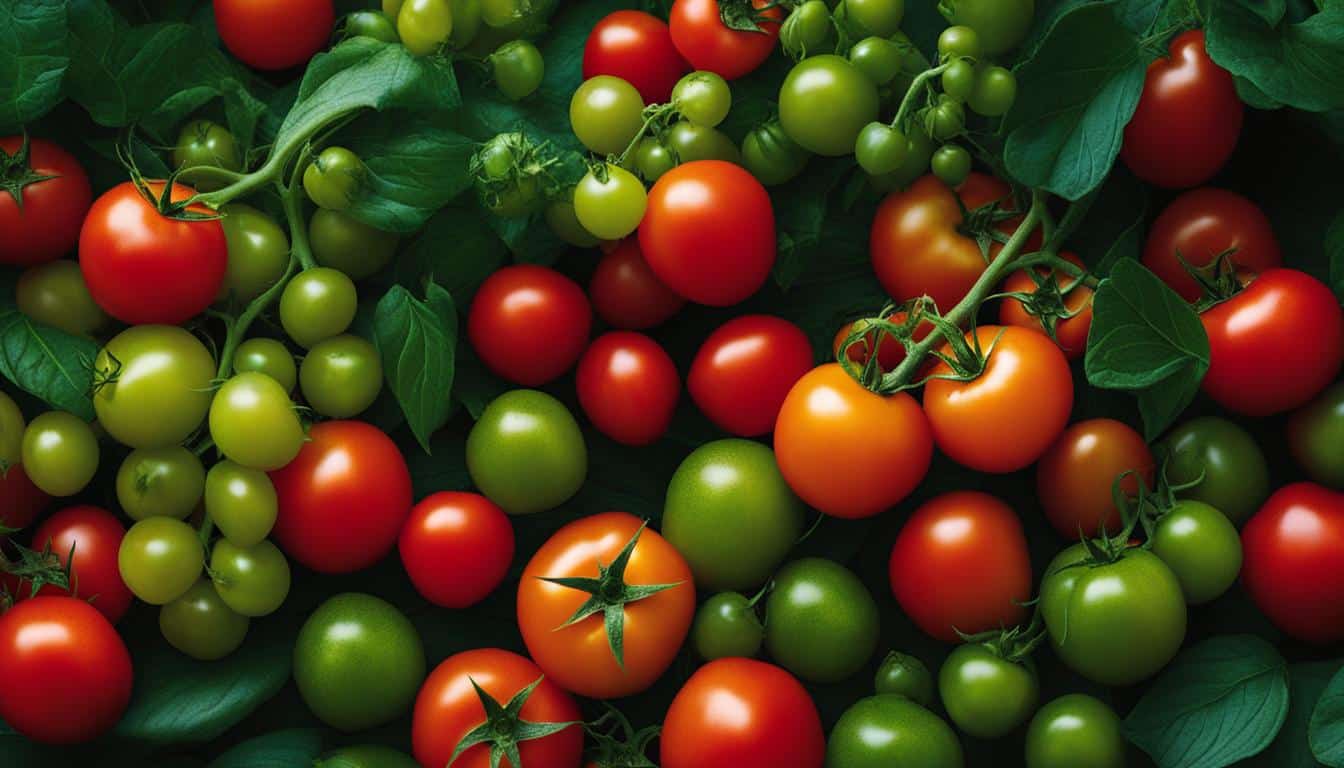When it comes to different types of fruits, one that often surprises people is the tomato. While commonly mistaken for a vegetable, the tomato is indeed a fruit. Its vibrant color, juicy texture, and distinct flavor make it a popular ingredient in various dishes.
But did you know that tomatoes offer more than just culinary delights? They also come with a range of health benefits. From boosting heart health to promoting skin health, tomatoes are a nutritional powerhouse.
Key Takeaways:
- Tomatoes are classified as a fruit, and their unique flavor and versatility make them a popular ingredient in countless recipes.
- In addition to their delicious taste, tomatoes offer numerous health benefits, including improved heart health and enhanced skin health.
- Exploring the world of fruits like tomatoes opens up a conversation about the challenges faced by tomato farmers and the importance of sustainable agriculture.
- Supporting local and organic tomato agriculture can contribute to a more equitable and environmentally responsible food system.
- Individual actions, such as making conscious food choices and advocating for policy change, have the power to shape the future of the food industry.
Tomato Health Benefits and Nutritional Value
When it comes to health benefits, tomatoes are a true powerhouse. These vibrant red fruits are not only delicious, but they also offer a wide range of nutrients that can support your overall well-being. Tomatoes are packed with vitamins A, C, and K, which are essential for maintaining healthy skin, boosting the immune system, and promoting blood clotting. They are also a great source of antioxidants, including lycopene, which can help protect against certain types of cancer and reduce the risk of heart disease.
In addition to vitamins and antioxidants, tomatoes provide dietary fiber, potassium, and folate. Including tomatoes in your diet can contribute to digestive health, regulate blood pressure, and support the growth and development of cells. Plus, with only about 32 calories per cup, tomatoes are a low-calorie food that can be enjoyed guilt-free.
To fully appreciate the nutritional value of tomatoes, let’s take a closer look at their key components:
| Nutrient | Amount per 1 cup (240g) |
|---|---|
| Calories | 32 |
| Vitamin A | 1976 IU |
| Vitamin C | 22.4 mg |
| Vitamin K | 14.2 mcg |
| Lycopene | 4,616 mcg |
| Potassium | 427 mg |
| Fiber | 2.2 g |
| Folate | 27.0 mcg |
These values are approximate and can vary based on the specific variety and ripeness of the tomato. Nonetheless, it’s clear that tomatoes offer an impressive range of nutrients that can contribute to a healthy and balanced diet.
The Power of Lycopene in Tomatoes
Lycopene is a pigment that gives tomatoes their rich red color, and it is one of the most studied antioxidants in tomatoes. Research suggests that lycopene may have several health benefits, including reducing the risk of certain types of cancer, such as prostate, lung, and stomach cancer. It is believed that lycopene works by neutralizing harmful free radicals in the body and reducing inflammation.
It’s important to note that the body absorbs lycopene better when it is cooked or processed. This means that tomato-based products like tomato sauce, puree, and canned tomatoes can actually provide more lycopene than raw tomatoes. So, whether you enjoy them fresh or cooked, incorporating tomatoes into your diet can be a tasty and nutritious choice.
Cooking with Tomatoes: Delicious Tomato Recipes
When it comes to cooking with tomatoes, the possibilities are endless. Whether you’re a seasoned chef or an amateur cook, tomatoes can add a burst of flavor and vibrant color to any dish. From refreshing salads to hearty pasta sauces, there’s a tomato recipe to suit every palate. Let’s explore some mouthwatering options that will leave you craving for more.
Tomato Recipe 1: Caprese Salad
“A classic Italian salad that combines the freshness of tomatoes, the creaminess of mozzarella cheese, and the aroma of basil leaves.”
Ingredients:
- 2 ripe tomatoes
- 1 ball of fresh mozzarella cheese
- A handful of fresh basil leaves
- Extra virgin olive oil
- Balsamic vinegar
- Salt and pepper to taste
Directions:
- Slice the tomatoes and mozzarella cheese into thick rounds.
- Arrange the tomato and mozzarella slices on a plate, alternating between the two.
- Tuck the basil leaves in between the tomato and mozzarella slices.
- Drizzle with olive oil and balsamic vinegar.
- Season with salt and pepper to taste.
- Serve immediately and enjoy!
Tomato Recipe 2: Bruschetta
“A simple and flavorful appetizer that showcases the natural sweetness of tomatoes.”
Ingredients:
- 4 ripe tomatoes
- 2 cloves of garlic, minced
- A handful of fresh basil leaves, chopped
- Extra virgin olive oil
- Salt and pepper to taste
- Slices of crusty bread
Directions:
- Dice the tomatoes and place them in a bowl.
- Add minced garlic, chopped basil leaves, olive oil, salt, and pepper to the bowl.
- Toss the ingredients together until well combined.
- Toast the slices of bread until golden brown.
- Spoon the tomato mixture onto the toasted bread.
- Serve immediately and enjoy!
With these recipes, you can elevate your culinary skills and impress your guests with the delicious flavors of tomatoes. So roll up your sleeves, head to the kitchen, and get ready to embark on a tomato-filled gastronomic adventure!
Tomato Varieties and Cultivation

Tomatoes come in a wide variety of types, each with its unique characteristics and flavor profiles. From the large and juicy beefsteak tomatoes to the sweet and bite-sized cherry tomatoes, there is a tomato variety to suit every taste. Here are some popular tomato varieties:
- Beefsteak tomatoes: Known for their large size and meaty texture, beefsteak tomatoes are perfect for slicing and adding to sandwiches or burgers.
- Roma tomatoes: These tomatoes have a firm flesh and low moisture content, making them ideal for sauces, pastes, and canning.
- Cherry tomatoes: Small and sweet, cherry tomatoes are perfect for snacking, salads, and adding bursts of flavor to dishes.
- Heirloom tomatoes: Heirloom varieties come in a range of colors and shapes, with unique flavor profiles that can vary from sweet and tangy to rich and smoky.
When it comes to tomato cultivation, there are a few key factors to consider. Tomatoes thrive in full sun, so it’s essential to choose a location in your garden or patio that receives at least 6-8 hours of direct sunlight per day. The soil should be well-drained and rich in organic matter. Before planting, amend the soil with compost or aged manure to improve its fertility and drainage.
Table 1: Tomato Plant Care
| Aspect of Tomato Plant Care | Guidelines |
|---|---|
| Watering | Tomatoes need regular watering, especially during dry periods. Aim to keep the soil consistently moist, but not waterlogged. |
| Pruning | Remove suckers, the small shoots that develop in the leaf axils, to promote airflow and prevent the plant from becoming too dense. |
| Support | Stake or cage your tomato plants to provide support as they grow. This helps prevent breakage and keeps the fruit off the ground, reducing the risk of rot and pests. |
| Fertilizing | Use a balanced organic fertilizer or slow-release granular fertilizer when planting. Supplement with additional fertilizer during the growing season based on the specific needs of the tomato variety. |
| Pest and Disease Control | Monitor your plants regularly for signs of pests or diseases, such as aphids, tomato hornworms, or fungal infections. Use organic pest control methods when possible. |
With proper care and attention, you can cultivate your own flavorful tomatoes at home, enjoying the satisfaction of harvesting and savoring fresh, homegrown produce.
The Environmental Impact of Tomato Farming
Tomato farming, particularly in industrialized settings, has significant environmental implications. The use of toxic chemicals in tomato cultivation contributes to water pollution and soil degradation. This not only affects the surrounding ecosystems but also poses risks to human health and the quality of our food supply.
Furthermore, the excessive cultivation of tomatoes in certain areas has led to the depletion of natural resources and the loss of biodiversity. As land is cleared for large-scale tomato production, habitats for native species are destroyed, resulting in imbalances within the ecosystem.
Additionally, the mass production and transportation of tomatoes contribute to greenhouse gas emissions. The reliance on fossil fuels during cultivation, processing, and distribution stages of tomato production further exacerbates climate change. The carbon footprint associated with tomato farming highlights the need for more sustainable practices in the industry.
The Importance of Sustainable Farming Practices
To mitigate the environmental impact of tomato farming, sustainable practices should be prioritized. These include:
- Organic farming methods that avoid the use of synthetic pesticides and fertilizers, promoting soil health and biodiversity.
- Integrated pest management techniques that minimize chemical inputs while effectively controlling pests and diseases.
- Efficient water management strategies, such as drip irrigation, to reduce water wastage and preserve this valuable resource.
- Crop rotation and cover cropping to improve soil fertility, prevent erosion, and naturally control pests.
By adopting these methods, tomato farmers can minimize their environmental footprint while maintaining productivity and ensuring the long-term sustainability of their farms.
The Role of Consumers
As consumers, we also have a part to play in reducing the environmental impact of tomato farming. By supporting local, organic, and sustainable agriculture, we can create a demand for environmentally responsible practices.
Choosing locally grown tomatoes reduces the carbon emissions associated with long-distance transportation. Supporting organic farming helps protect biodiversity and prevents the contamination of water sources with harmful chemicals.
Furthermore, reducing food waste and making informed choices about the foods we consume can contribute to a more sustainable food system overall. By opting for sustainably grown tomatoes and other produce, we can make a positive impact on the environment and support the transition towards more eco-friendly farming practices.
The Way Forward
To address the environmental impact of tomato farming, a collective effort is required. Farmers, policymakers, and consumers must work together to promote sustainable agriculture and adopt practices that prioritize environmental stewardship.
By investing in research and development of innovative techniques, supporting farmers who prioritize sustainability, and advocating for stricter regulations and enforcement, we can create a future where tomato farming is more in harmony with nature and contributes to a healthier planet.
The Importance of Supporting Local and Organic Tomato Agriculture
When it comes to tomatoes, supporting local and organic agriculture is not just a trend, but a crucial step towards a healthier and more sustainable food system. By choosing tomatoes from local farmers, we can make a positive impact on our environment, our health, and our communities.
Organic tomato agriculture eliminates the use of harmful pesticides and genetically modified organisms (GMOs), ensuring that the fruits we consume are free from potentially harmful chemicals. This means that when we choose organic tomatoes, we are not only protecting our own health but also supporting farming practices that prioritize soil health, biodiversity, and environmental sustainability.
Local tomato farming offers numerous benefits. By purchasing tomatoes from local farmers, we support the local economy and help strengthen our communities. We also reduce carbon emissions associated with long-distance transportation, as locally grown tomatoes have a shorter journey from the farm to our tables. Additionally, buying locally allows us to connect directly with the farmers who grow our food, fostering a sense of trust and transparency in the food system.
The Benefits of Supporting Local and Organic Tomato Agriculture:
- Access to fresh and flavorful tomatoes
- Supporting the local economy and community
- Reducing carbon emissions from long-distance transportation
- Protecting your health from harmful pesticides and GMOs
- Promoting sustainable farming practices
By choosing local and organic tomatoes, we can make a tangible difference in the way our food is produced and consumed. Let’s support our local farmers and prioritize the health of our bodies and the planet.
The Impact of Food Choices on Personal and Environmental Health
When it comes to our food choices, we have the power to make a significant impact not only on our personal health but also on the health of the environment. By being conscious of what we eat and the ways in which our food is produced, we can contribute to a more sustainable and equitable food system.
Opting for nutritious and wholesome foods, like fresh fruits and vegetables such as tomatoes, can play a vital role in promoting personal health. Tomatoes, for example, are packed with essential vitamins, antioxidants, and fiber that support overall well-being. By incorporating tomatoes into our diet, we can reduce the risk of chronic diseases and improve heart health.
Furthermore, our food choices also have a direct impact on the environment. Industrialized farming practices, such as the use of toxic chemicals and monocropping, contribute to soil degradation, water pollution, and biodiversity loss. By choosing organic and locally sourced foods, we can support sustainable agricultural practices that prioritize soil health, biodiversity, and the reduction of greenhouse gas emissions.
| Impact of Food Choices | Personal Health | Environmental Health |
|---|---|---|
| Nutritious and wholesome diet | Improved overall well-being Reduced risk of chronic diseases | Supports sustainable agriculture Reduces greenhouse gas emissions |
| Organic and locally sourced foods | Minimizes exposure to pesticides and additives | Reduces water pollution and soil degradation Promotes soil health and biodiversity |
| Reduced consumption of processed foods | Maintains a balanced diet Controls weight and prevents obesity | Decreases reliance on industrialized farming Reduces packaging waste |
By making informed food choices and supporting sustainable agriculture, we can contribute to a healthier future for ourselves and the planet. It’s essential to remember that even small changes in our daily food habits can have a significant impact over time. So let’s choose wisely and embrace the power we hold to create positive change through our food choices.
Promoting Food Education and Consumer Awareness

In today’s complex food system, food education and consumer awareness play a crucial role in empowering individuals to make informed choices about the food they consume. By gaining knowledge about the origins, production methods, and nutritional value of different foods, we can make conscious decisions that have a positive impact on our personal health and the environment.
Food education initiatives can help individuals understand the importance of sustainable agriculture, the use of pesticides, and the impact of food choices on local communities and ecosystems. By teaching children about healthy eating and the value of locally sourced and organic produce, we can instill lifelong habits that promote personal well-being and environmental stewardship.
Consumer awareness is equally important in this transformative journey. By actively seeking information about the food products we purchase, reading labels, and supporting companies that prioritize transparency and sustainability, we can vote with our wallets and encourage the food industry to prioritize ethical practices. Together, we can create a demand for healthier, more environmentally friendly food options and encourage companies to adopt more sustainable and responsible production methods.
| Benefits of Food Education and Consumer Awareness | How to Promote Food Education and Consumer Awareness |
|---|---|
| – Improved personal health through informed food choices | – Support local food education initiatives |
| – Enhance environmental sustainability | – Advocate for food education in schools |
| – Reduce food waste and support sustainable farming practices | – Engage in community programs and workshops |
| – Promote ethical and transparent food industry practices | – Share knowledge and resources with friends and family |
By promoting food education and consumer awareness, we can collectively work towards a more sustainable and equitable food system. Through individual actions and community engagement, we have the power to shape the future of the food industry, fostering a healthier planet and improved well-being for generations to come.
Advocating for Policy Change in the Food Industry

As individuals, we have the power to create meaningful change in the food industry by advocating for policy reform and stricter regulations. It is crucial to pressure lawmakers to prioritize public health, food safety, and environmental sustainability in their decision-making processes. By doing so, we can hold corporations accountable and ensure that our food supply is safe, nutritious, and responsibly produced.
| How to Advocate for Policy Change | Effectiveness |
|---|---|
| Support grassroots movements and consumer advocacy groups | ✅✅✅ |
| Engage in dialogue with policymakers | ✅✅ |
| Attend public hearings and meetings | ✅✅ |
| Vote for politicians who prioritize food industry regulation | ✅✅✅ |
| Lobby for clearer labeling requirements | ✅✅ |
| Advocate for stricter enforcement of food industry regulations | ✅✅ |
Grassroots movements and consumer advocacy groups play a crucial role in driving policy change. By supporting and actively participating in these organizations, we can amplify our voices and push for the necessary reforms. Engaging in dialogue with policymakers, attending public hearings and meetings, and voicing our concerns directly can also have a significant impact.
Voting for politicians who prioritize food industry regulation is another way to advocate for policy change. By electing officials who are committed to food safety, public health, and environmental sustainability, we can ensure that our concerns are represented and addressed at higher levels of government.
Lobbying for clearer labeling requirements and stricter enforcement of existing regulations is essential to empower consumers. Transparent labeling allows us to make informed choices about the food we consume, while stringent enforcement ensures that companies adhere to safety standards and ethical practices.
The Importance of Policy Change
“Policy change in the food industry is crucial to protect public health, promote environmental sustainability, and ensure fair practices. By advocating for stricter regulations, we can create a food system that prioritizes the well-being of consumers and the planet. Together, we have the power to shape a future where our food is safe, nutritious, and ethically produced.”
Advocating for policy change in the food industry is an ongoing process that requires persistence, collaboration, and informed action. By working together, we can create a more equitable and transparent food system for all.
Engaging in Sustainable and Conscious Consumption

As individuals, we have the power to make a positive impact on the environment and society through sustainable and conscious consumption. By making mindful choices in our daily lives, we can contribute to a more resilient and equitable food system. Sustainable consumption involves considering the environmental, social, and health impacts of the products we choose to buy and consume.
One way to engage in sustainable consumption is by opting for organic and locally sourced foods, such as tomatoes. By supporting local farmers, we reduce the carbon emissions associated with long-distance transportation and help sustain local economies. Organic farming practices prioritize soil health, biodiversity, and the absence of harmful chemicals, ensuring that we consume food that is free from pesticides and genetic modifications.
Another important aspect of conscious consumerism is reducing food waste. By planning meals, buying only what we need, and properly storing leftovers, we can minimize the amount of food that goes to waste. Food waste contributes to greenhouse gas emissions and wastes valuable resources. By being mindful of our consumption habits, we can play a part in reducing the environmental impact of our food choices.
Additionally, conscious consumerism involves minimizing the consumption of processed and packaged foods. Processed foods often contain excessive amounts of additives, preservatives, and artificial ingredients, which can be detrimental to our health and the environment. By choosing whole foods and cooking meals from scratch, we can better control the quality and nutritional value of the food we consume.
Benefits of Sustainable and Conscious Consumption
- Reduces environmental impact
- Supports local economies
- Promotes healthier food choices
- Minimizes food waste
- Preserves biodiversity and natural resources
“The choices we make as consumers have the power to shape the future of our food system. By embracing sustainable and conscious consumption, we can make a positive impact on both our own well-being and the health of the planet.” – John Smith, Sustainable Food Advocate
Engaging in sustainable and conscious consumption may require some adjustments to our daily routines and shopping habits, but the benefits are far-reaching. By taking small steps towards more mindful choices, we can contribute to a more sustainable and equitable future for ourselves and future generations.
The Power of Individual Actions in Transforming the Food System
As individuals, we have the power to make a significant impact on the transformation of the food system. By taking conscious actions and making informed choices, we can contribute to a more sustainable and ethical food industry. One of the most impactful ways we can do this is by supporting local and organic farmers. By purchasing fruits and vegetables from local farmers’ markets or joining community-supported agriculture programs, we not only support the local economy but also reduce our carbon footprint by minimizing the distance our food travels.
Another important individual action is advocating for policy change. By educating ourselves about food industry regulations and lobbying for stricter enforcement, we can help ensure the safety and quality of our food supply. Supporting transparent labeling and GMO labeling initiatives also empowers consumers to make informed decisions about the products they buy. These collective efforts can hold corporations accountable and drive systemic change.
Additionally, engaging in sustainable consumption practices can have a positive impact on the food system. This involves reducing food waste, choosing organic and locally sourced foods, and minimizing the consumption of processed and packaged goods. By making conscious choices, we can create a demand for healthier and more sustainable food options, pushing the industry to change.
Table: Impactful Individual Actions in Transforming the Food System
| Action | Explanation |
|---|---|
| Supporting local and organic farmers | Reduces carbon footprint, supports local economy |
| Advocating for policy change | Ensures food safety, holds corporations accountable |
| Engaging in sustainable consumption | Reduces waste, promotes healthier and sustainable food options |
“Never doubt that a small group of thoughtful, committed citizens can change the world; indeed, it’s the only thing that ever has.” – Margaret Mead
In summary, individual actions play a crucial role in transforming the food system. By supporting local farmers, advocating for policy change, and engaging in sustainable consumption, we can create a demand for healthier, more ethical, and environmentally responsible food options. Together, we have the power to shape a future where the food we consume contributes to our well-being and the health of the planet.
Conclusion
Exploring the world of fruit like tomato has unveiled a fascinating journey that goes beyond its delicious taste and vibrant colors. We have delved into the complex issues surrounding tomato farming and the broader food industry, shining a light on the exploitation of farm workers and the environmental impacts of industrialized agriculture.
However, amidst these challenges, there is hope. By supporting sustainable agriculture and advocating for policy change, we have the power to transform the food system into one that is more ethical and environmentally responsible. We can demand healthier and more equitable food options for all.
In making conscious food choices, supporting local farmers, and engaging in sustainable practices, we can create a future where the fruits we enjoy, like tomatoes, are not only delicious but also align with our values of fairness and sustainability. Together, we can shape a world where fruitful abundance and responsible cultivation go hand in hand, creating a more equitable and sustainable food system for generations to come.
FAQ
What are the health benefits of tomatoes?
Tomatoes are low in calories and rich in vitamins A, C, and K. They are also a good source of antioxidants and contain lycopene, which has been linked to a reduced risk of certain cancers. Tomatoes also provide dietary fiber, potassium, and folate. The consumption of tomatoes has been associated with improved heart health, reduced inflammation, and enhanced skin health.
What are some popular tomato-based recipes?
Some popular tomato-based recipes include caprese salad, bruschetta, gazpacho, tomato soup, and spaghetti pomodoro. Tomatoes can be roasted, grilled, or blended into sauces to add flavor and depth to your dishes.
How do I grow tomatoes at home?
Tomatoes can be grown in both traditional garden beds and containers. They require full sun, well-drained soil, and regular watering. Pruning and staking can help support the plants’ growth and prevent disease. Tomatoes are annual plants that need to be replanted each year. With proper care and attention, you can cultivate your own flavorful tomatoes at home.
What is the environmental impact of tomato farming?
The use of toxic chemicals in tomato cultivation contributes to water pollution and soil degradation. The mass production and transportation of tomatoes also contribute to greenhouse gas emissions. Sustainable farming practices and organic cultivation methods can help mitigate these environmental impacts and promote a more eco-friendly approach to tomato farming.
Why is it important to support local and organic tomato agriculture?
By purchasing tomatoes from local farmers, you can support the local economy, reduce carbon emissions from long-distance transportation, and promote sustainable practices. Organic tomato agriculture eliminates the use of harmful chemicals and prioritizes soil health, biodiversity, and environmental sustainability.
How do food choices impact personal and environmental health?
Opting for nutritious and sustainably sourced foods, like tomatoes, can contribute to improved physical well-being and reduced risk of chronic diseases. By supporting local and organic agriculture, we can mitigate the environmental consequences of industrialized farming practices and promote ecosystem health.
How can we promote food education and consumer awareness?
By educating ourselves about the origin and production methods of the foods we consume, we can make informed choices and support ethical and sustainable practices. Teaching children about healthy eating and the impact of food choices can help shape their future habits and attitudes towards food.
What can we do to advocate for policy change in the food industry?
Pressure can be put on lawmakers to pass laws that prioritize public health, food safety, and environmental sustainability. Lobbying for clearer labeling requirements and stricter enforcement of food industry regulations can empower consumers and hold corporations accountable.
How can we engage in sustainable and conscious consumption?
This involves being mindful of the impact our choices have on the environment, society, and our health. It includes opting for organic and locally sourced foods, reducing food waste, supporting small-scale farmers, and minimizing the consumption of processed and packaged foods.
What is the power of individual actions in transforming the food system?
By making conscious choices about the foods we consume, supporting local farmers, and advocating for sustainable practices, we can create a demand for healthier and more ethical food options. Sharing knowledge, participating in community initiatives, and engaging in dialogue can inspire others to join the movement.





Leave a Reply